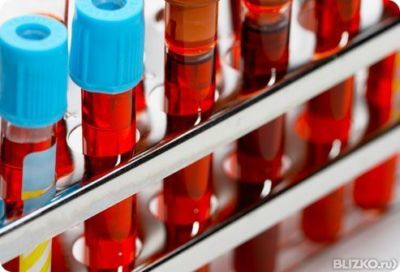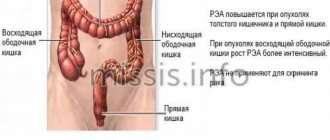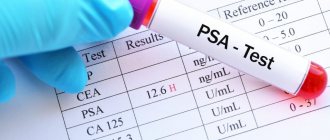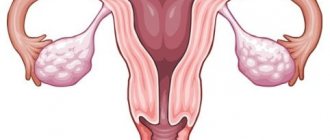18457 May 13
IMPORTANT!
The information in this section cannot be used for self-diagnosis and self-treatment.
In case of pain or other exacerbation of the disease, diagnostic tests should be prescribed only by the attending physician. To make a diagnosis and properly prescribe treatment, you should contact your doctor. We remind you that independent interpretation of the results is unacceptable, the information below is for reference only
General PSA (general prostate specific antigen): indications for use, rules for preparing for the test, interpretation of results and normal indicators.
Detailed description of the study
Prostate specific antigen (PSA) is a protein produced by prostate tissue. The role of this protein is to prevent the thickening of testicular fluid, which is achieved by breaking down certain compounds into pieces. A certain amount of PSA passes through the layer of epithelial cells of the prostate gland and enters the bloodstream.
As men age, sperm production changes, resulting in a negative impact on the quantity and quality of sperm and impairs reproductive function. PSA production increases with age. Its excessive secretion is observed in conditions such as benign prostatic hyperplasia (BPH), which is manifested by an increase in size and a change in the structure of this organ.
BPH symptoms tend to progress over time. Frequent urination is observed, including at night, which is due to insufficient emptying of the bladder. In addition, compression of the urinary tract by the enlarged gland causes a decrease in the force of the stream during urination and its intermittent nature. The progression of the disease leads to the periodic release of drops of urine from the urethra outside the process of urination.
In case of unfavorable conditions, such as prolonged inability to empty the bladder, hypothermia, or taking certain medications, acute urinary retention may occur due to BPH.
Prostate cancer is one of the most common cancers in older men. It is the world's second leading cause of cancer death among men. Often this disease occurs against the background of existing BPH. Because of this, the symptoms of prostate cancer at the onset of the disease may not differ from those of BPH.
The progression of the disease leads to pain in the pelvis and lower back due to compression of the ureters and dilation of the renal pelvis. Erectile dysfunction is typical. The growth of a tumor into the rectum interferes with the release of its contents. A person may also notice pain in the anal area and the appearance of blood in the stool.
Prostate cancer, like any oncological process, is characterized by the occurrence of pathological fatigue, weakness, loss of appetite and weight, and the presence of fever. Timely detection of the disease makes it possible to successfully treat prostate cancer.
Determining PSA levels is one of the methods for early detection of prostate cancer.
Dynamics of changes in total PSA levels over time, PSA V
An important criterion for assessing the pathological process is the dynamics of changes in the level of total PSA over time. This indicator is called PSA V. The increase in PSA levels in prostate cancer occurs at a much faster rate than in BPH (prostate adenoma) or chronic prostatitis. Sarklinik in Saratov believes that the limit for the annual increase in PSA levels over 1 year should be no more than 0.67 ng/ml . That is, the increase in PSA in one year should be a maximum of up to 0.67 ng/ml, compared to the previous year. Over 6 months (if PSA is performed once every 6 months), the increase in PSA level should be no more than 0.33 ng/ml .
Dear patients, if you want to receive detailed information on the following issues, please contact us for a personal consultation in Saratov: what is a tumor marker analysis of a dog, where is a dog’s blood test performed and its decoding , what is the norm, how is the test carried out, where can a dog’s blood test be done and passed, when to get the results, how to prepare for the dog test , what is its cost and price, how to deal with impotence , how to treat early ejaculation? The PSA blood test is a highly informative screening test!
If you are undergoing a routine examination and you are over 45 years old, then take: total PSA, free PSA, prostate health index .
Photo: Rob3000 | Dreamstime.com\Dreamstock.ru
If you have any questions related to PSA, total PSA, free PSA, prostate specific antigen, what is multiparametric MRI of the prostate (mpMRI), PIRADS (Prostate Imaging Reporting and Data System), ask your doctor on the website sarclinic.ru!
Related posts:
Chlamydia in men, women, signs, symptoms, treatment in Saratov
Prostate massage and digital rectal examination of the prostate gland
Prostatitis: classification, types of prostatitis, forms of prostatitis
Symptoms of chronic prostatitis in men
Prostate gland sizes, prostate size, normal sizes, normal, volume, volumes
Comments ()
What do you need to know about preparing for analysis?
To obtain a reliable result of a laboratory test, it is necessary to devote time to the preparatory stage.
It is very important to properly prepare for a PSA blood test.
The process does not require much effort or complex manipulations. There are a number of recommendations that must be followed before taking a PSA test.
Diagnostic and therapeutic manipulations related to the reproductive system in men can distort laboratory test results. There is a list of procedures that increase PSA levels in blood serum. Therefore, they should be temporarily excluded before donating blood for PSA.
Important ! It is advisable to start planning the preparatory stage a month before the laboratory test, and in some cases – six months before.

Sometimes it is recommended to start preparing six months before the test.
Cancer screening for PSA after transurethral resection can be performed no earlier than six months later.
The reliability of the analysis is influenced by diagnostic studies (TRUS, colonoscopy, bladder catheterization), physiotherapy sessions, and laser therapy. You can donate blood for analysis only 7-10 days after these procedures.
Prostate massage significantly increases the level of tumor marker in the analysis. The break between the session and blood sampling should be at least 2-3 days.

Prostate massage may increase PSA levels in the blood
2-3 days before the study, it is necessary to review the organization of meals. Fatty, spicy foods, smoked foods, spices, fried foods, and canned food are excluded from the diet. You should avoid eating fast food that contains excess amounts of refined carbohydrates, sugar, unhealthy fats, sodium and insufficient fiber. Alcoholic beverages should be avoided.
Important ! The optimal menu includes fish, fresh vegetables and fruits, and porridge balanced in composition of fats, proteins and carbohydrates.
Ejaculation (ejaculation) increases serum PSA levels. Abstaining from sexual activity at least two days before the test will help avoid diagnostic errors.

You should abstain from sexual intercourse and masturbation for at least two days before taking the test.
A few days before blood sampling, it is necessary to exclude active physical exercises associated with tension in the muscles of the pelvic girdle - cycling, horse riding, strength exercises in a sitting position, deadlift. The level of prostate specific antigen in the blood serum can be affected by excessive physical activity - moving heavy objects, working in the garden.
Compliance with intervals of functional rest of the prostate and special requirements for lifestyle will eliminate the possibility of false readings in the study for prostate specific antigen.
The issue of drug withdrawal is resolved individually. This primarily concerns medications for the treatment of prostate adenoma.

Before taking the test, you should consult a doctor who may recommend temporarily stopping certain medications.
A patient or person undergoing a routine examination experiences understandable nervous tension while awaiting the result. This can lead to negative changes in life activity - fluctuations in blood pressure, heart rate, headaches, and insomnia. It is necessary to maintain balance of feelings, a positive attitude, and avoid anything that leads to overwork, loss of strength, and depression.
The process of deciphering the results
Both blood sampling and interpretation of the obtained data are carried out by experienced doctors, who will maximize the diagnostic potential and help in a speedy recovery.
The results of the study are based on measuring the level of bound and free PSA contained in the blood. Free PSA is a fraction of the total protein, and the bound antigen is a complex of alpha 2 macroglobulin and free PSA. In addition to the quantitative content of the antigen, the percentage of two indicators is important: the total fraction and the unbound one.
There are two types of diagnostics in medicine:
- Total PSA analysis. It is carried out when there is a suspicion of pancreatic pathology, it provides an opportunity to more or less accurately determine the diagnosis. The basis of the method is to compare the results obtained with the norm.
- Free PSA assay. Used to clarify the diagnosis and adjust treatment.
General PSA

The normal level of total PSA is considered to be up to 4 ng/ml of blood. But in the last 10-15 years, this figure has decreased to 2 ng/ml, because approximately a third of oncological diseases cannot be detected at a rate of 4 ng. If the concentration is increased, then the person himself may suspect that something is wrong: often with diseases of the prostate, temporary impotence is noted, difficulty urinating, or the process causes discomfort.
If the content of the total fraction is increased, then the probable development of prostatitis, prostate cancer, and prostate adenoma is assumed. But it’s not worth talking about the diagnosis right away, because the results of the study are subject to distortion, mainly: violation of the rules for donating blood or individual characteristics of the body. First of all, these are: cycling, prostate surgery, recent ejaculation, the presence of other male diseases.
Free PSA
The level of the free fraction varies depending on age: the older the person, the greater the concentration. This is due to an increase in the size of the prostate secretion - according to statistics, by 3-4 mm/year, respectively, the more specific tissues, the more secretion is released.
According to statistics, the norm when checking the total PSA content is up to 0.93 ng/ml, but this figure is very variable - age plays an important role. A good ratio of free PSA to total: from 15 to 70%.
Recommended topic:
Prostate atony

Depending on the shared PSA, decrypting the free PSA data may have completely opposite results. So, with a level of total secretion from 4 ng/mg to 10 ng/ml, with benign formations in the pancreas, the percentage will be up to 15%. But, according to statistics, benign formations are detected when the level of free PSA increases (with the exception of benign prostatic hyperplasia), if the level decreases, oncology is very likely.
If the indicator changes upward, damage to pancreatic tissue in the form of a non-cancerous pathology is possible; if it changes less, an oncological tumor is most likely developing.
PSA test: preparing for the test
Determining the level of prostate specific antigen has several purposes:
- screening for prostate tumors in men at risk;
- monitoring the therapeutic effect in the treatment of prostate diseases;
- substantiation of diagnosis for suspected prostate disease;
- dynamics (monitoring) of the postoperative period.







